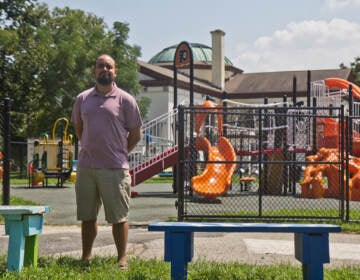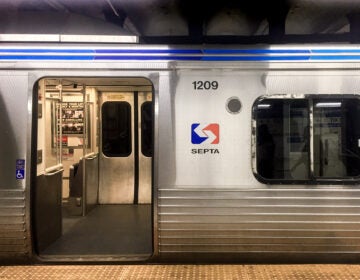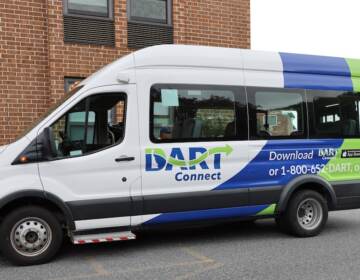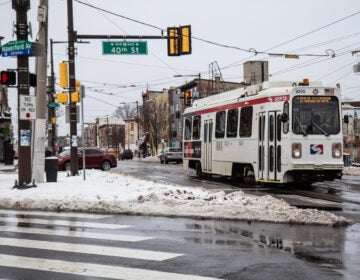It’s time to tell our regional planning overlords to stop throwing money at highways
The Delaware Valley Regional Planning Commission’s Connections2050 plan could be our chance to change the math on highway spending.
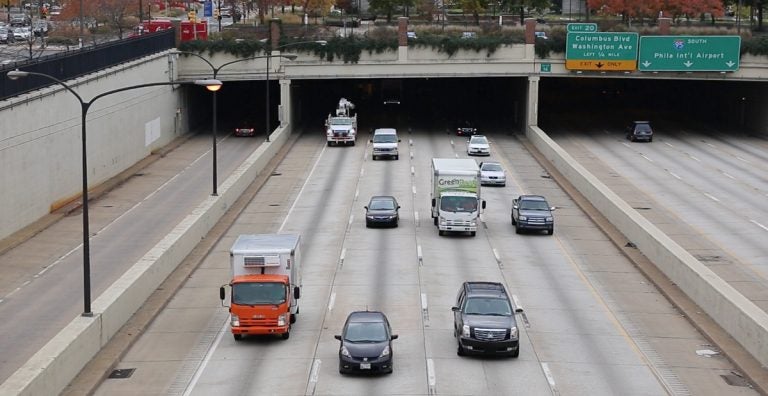
Trucks and cars move northbound on Interstate 95 in Philadelphia. (Lindsay Lazarski/WHYY)
In 2008, Joe Biden shared a quote his father had told him: “Don’t tell me what you value. Show me your budget, and I’ll tell you what you value.”
With the passage of the Infrastructure Investment and Jobs Act in the Senate on August 10, Congress has shown what it will value in terms of transportation infrastructure, as far as a bipartisan framework will take us. While the upcoming reconciliation process may prove more transformative, the bill is a raw deal for transit, which saw a $10 billion funding cut from the original House proposal, while highway funding ballooned an additional $100 billion. It constitutes the largest single spending program for highways since the original Interstate Highway System buildout, with projects in the American South, West, and Sunbelt largely to benefit — projects including Houston’s I-45 expansion, Portland’s I-5 Rose Quarter widening, and the 1,300-mile-long Interstate 14 stretching from Georgia to Texas.
For the Philadelphia region, which saw 2020 Census population growth figures modestly grow but not sprawl along its highways to the extent those regions have, the case for highway widening seems even more unjustified. And with work commutes poised to be permanently reduced in varying degrees of hybrid schedules, it seems more appropriate than ever to gauge our transportation capacity needs on typical rather than peak-hour levels.
But even before the infrastructure bill was discussed, the Philadelphia region consistently advanced and prioritized highway expansions over transit, and our regional planning budgets prove it clearly.
Connections2050 is the long-range plan published by the Delaware Valley Regional Planning Commission. In order to qualify for federal funding, every metropolitan planning organization in the US, which includes DVRPC, must compile such a long-range plan every four years, updated with the latest demographic trends and candidate projects submitted from agencies like PennDOT and SEPTA. Since the last plan, SEPTA has struggled to even advance its top four Projects of Regional Significance, which include modernizing Regional Rail and Trolley Modernization, despite positive-sounding affirmations from planners and politicians. But in the background, another set of enormous transportation investments keep on churning away, without so much as an acknowledgement from elected officials: highway and roadway widening.
The single costliest project in the last several decades, 95Revive, has cost $2.7 billion, with further rebuilding to South Philadelphia pegged at over $7 billion. But plenty of other explicit highway widenings in Connections2050, including US 30 in Downingtown, US-1 in Lower Bucks, US 322 in Delaware County, total over $3 billion. And with the Senate’s removal of a “fix-it-first” spending policy in the infrastructure bill, all these sprawl-inducing, climate-threatening projects are instantly eligible for generous grant funding. Using Act 89 funds, PennDOT is all-in on using state funding to match these grants, but the agency and Harrisburg legislators continue to balk at guaranteeing anything similar for transit, leaving Philadelphia and other cities in the cold. Not a single transit project has fully guaranteed funding, despite a report that pretends there is funding parity. Make no mistake: the quality-of-life of over 380,000 Market-Frankford El, trolley, and Regional Rail riders is in dire jeopardy in favor of slightly improving a suburban driving commute that may not even exist post-2020.
It’s not like DVRPC doesn’t know this. The Connections2050 narrative portion goes farther than ever before to acknowledge the history of structural racism embedded in transportation systems. In an unprecedented Black Lives Matter Protests section, it reads: “In many areas, Interstates and highways were aligned in a manner that cut off Black neighborhoods from the wider community… It is clear that the transportation sector has a long way to go to make up for past transgressions and current shortcomings if it is going to equitably serve everyone.” DVRPC also hosted multiple Connections2050 roundtable discussions with the public. When I attended, the overwhelming consensus was to stop all roadway expansion in favor of restorative investments in transit and active mobility across the region.
But the truth is, these kinds of projects are largely outright ignored by PennDOT and elected officials left and right.
Under DVRPC’s governance structure, the agency itself is largely powerless to propose or regulate any project that lands on their table. The political status quo has been to rubber-stamp projects through, irrespective of truly intermodal, climate, and mobility-focused long-term planning. Just the other day, DVRPC spoke on the need to consider travel needs for the city’s exploding immigrant population — yet a measly Roosevelt Boulevard surface line (not a subway as others have hoped) remains unfunded.
In this depressing situation, how can the public respond? There are a few more days to submit public comment on Connections2050, until August 31. I encourage commenters to note the stark disconnect between DVRPC’s stated policy goals and what they’re actually funding in the budgets. It is also vital to urge local Congresspeople to support the upcoming budget reconciliation process so Philadelphia’s transit projects like Trolley Modernization can get funded with more federal support. With yet another confirmation we’re living in a full-blown climate crisis, both Connections2050 and the national infrastructure dialogue seem to only prolong the zero-sum status quo — so it’s time for those concerned to speak up even louder, both in these obscure planning efforts and in the public realm.

Subscribe to PlanPhilly
WHYY is your source for fact-based, in-depth journalism and information. As a nonprofit organization, we rely on financial support from readers like you. Please give today.



